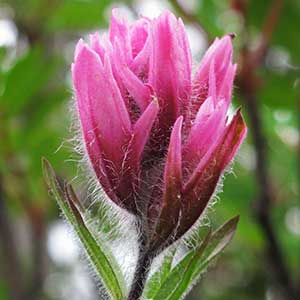Castilleja parviflora var. olympica
Castilleja parviflora var. oreopola
Olympic Indian paintbrush, Olympic Mountains paintbrush, Olympic paintbrush
magenta Indian paintbrush, magenta paintbrush
broadly lanceolate, rarely linear, margins plane, (0–)3(–5)-lobed, apex narrowly acute to acuminate;
lobes spreading, linear to lanceolate, lateral lobes nearly as long as terminal.
broadly lanceolate to rarely linear, margins plane to ± wavy, (0–)3(–5)-lobed, apex acuminate to acute;
lobes spreading or ascending, linear, very narrow.
distally pink-purple, magenta, deep rose, or crimson, rarely white, 3–7-lobed;
lobes lanceolate, arising near to above mid length.
distally magenta to pink or pink-purple, sometimes red, red-orange, deep rose, or crimson, rarely whitish, 3–7-lobed;
lobes linear, arising below or above mid length.
12–20(–25) mm;
tube 8.5–19 mm;
beak exserted, (5.5–)7–9(–11) mm;
abaxial lip green;
teeth green.
(18–)20–30 mm;
tube 12–19 mm;
beak exserted, 8–11 mm;
abaxial lip green, sometimes purple;
teeth green, red, or white.
deep purple with magenta or light pink lobes, 13–20(–28) mm;
abaxial clefts 6.5–12 mm, adaxial 7–15 mm, lateral 2–8 mm, 10–35% of calyx length;
lobes narrowly triangular, apex acute to obtuse.
colored as bracts, 20–28 mm;
abaxial clefts 8–13 mm, adaxial 10–14 mm, lateral 1–3 mm, 12–20% of calyx length;
lobes narrowly to broadly triangular, distally expanded and flaring, petaloid, apex obtuse to acute or rounded.
Castilleja parviflora var. olympica
Castilleja parviflora var. oreopola
Variety olympica is essentially endemic to the upper elevations of the Olympic Mountains, in northwestern Washington, though a handful of collections from high elevations on Vancouver Island, British Columbia, are also referable to this form.
(Discussion copyrighted by Flora of North America; reprinted with permission.)
Variety oreopola is restricted to the Cascade Range from central Oregon, near the Three Sisters peaks, to just north of Mt. Rainier, in Washington. It is replaced to the north in the Wenatchee Mountains and the North Cascade Range by var. albida. Variety oreopola usually has pink to purple inflorescences, with occasional variants of pinkish red, pinkish orange, or white. Its colorful displays are a conspicuous element of the subalpine meadows and slopes of this region. Reports of var. oreopola in the Cascade Mountains of southern British Columbia seem plausible but have yet to be fully verified.
(Discussion copyrighted by Flora of North America; reprinted with permission.)


